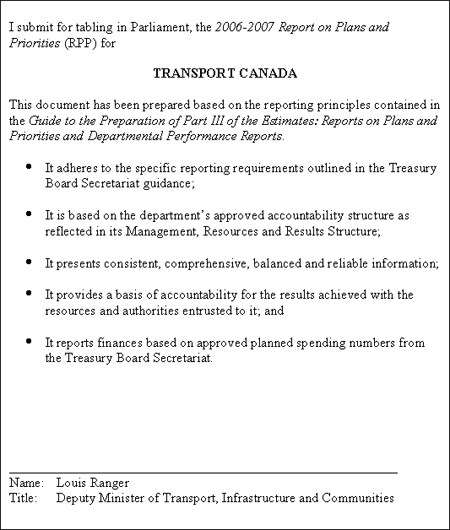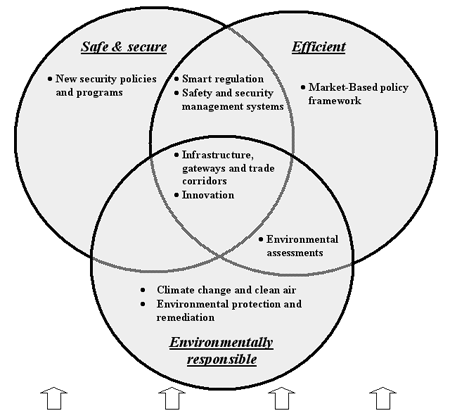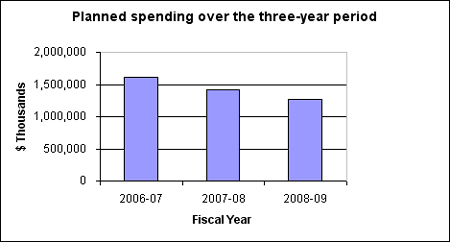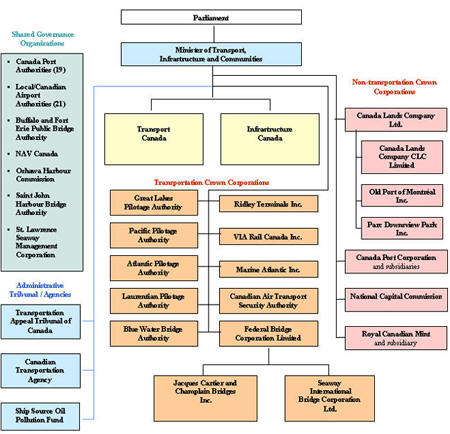Common menu bar links
Breadcrumb Trail
ARCHIVED - RPP 2006-2007
Transport Canada
 This page has been archived.
This page has been archived.
Archived Content
Information identified as archived on the Web is for reference, research or recordkeeping purposes. It has not been altered or updated after the date of archiving. Web pages that are archived on the Web are not subject to the Government of Canada Web Standards. As per the Communications Policy of the Government of Canada, you can request alternate formats on the "Contact Us" page.
Section I - Overview
1.1 Minister's Message

I am pleased to present Transport Canada's 2006-2007 Report on Plans and Priorities, which outlines the department's corporate direction for the next three fiscal years.
On February 6, 2006, the Prime Minister appointed me as Minister of Transport, Infrastructure and Communities, responsible for a portfolio consisting of Transport Canada, the subject of this report, Infrastructure Canada, and 16 Crown Corporations. The broad scope and synergies of this new portfolio create a point of convergence for some of the most important opportunities and key challenges facing Canada today. Bringing the various tools and policy levers of this portfolio under the responsibility of a single minister offers great potential for strategic and coherent policy development and actions aimed at enhancing Canada's economic competitiveness and our quality of life in a streamlined manner that is transparent and accountable to Canadians.
Throughout our history, transportation has played a central role in building the Canadian nation, and driving economic opportunity for its citizens. Bold ventures like crossing a rugged continent by rail, planning the Trans-Canada Highway, and building one of the world's first international airlines are achievements that captured the imagination of past generations.
Today, as commerce becomes increasingly dominated by the rapid movement of goods through seamless global supply chains, efficient, integrated transportation systems are more crucial than ever to competitiveness.
Transportation continues to be at the centre of a web of interconnected challenges. Infrastructure, international commerce, border management, safety, security, skills shortages, governance, and the need for shared vision and collaboration across jurisdictions and across public and private sectors are all "transportation" issues.
Within the integrative, system-wide context of the Canadian transportation sector, Transport Canada will be modernizing a number of statutory and regulatory instruments, including amendments to the Aeronautics Act and the Canada Transportation Act and proposals around the creation of new legislation, such as an International Bridges and Tunnels Act and a Canada Airports Act.
Efficient transportation systems, safety management, environmental responsibility, and the development of transportation security measures compatible with the effective flow of trade, continue to be importantpriorities for Transport Canada as the department moves on a variety of fronts, to position the Canadian transportation system for success.
The 2006-2007 Report on Plans and Priorities outlines the course of action on how Transport Canada intends on capitalizing on the opportunities associated with these priorities.
The Honourable Lawrence Cannon, P.C., M.P.
Minister of Transport, Infrastructure and Communities
1.2 Management Representation Statement

1.3 Transport, Infrastructure and Communities Portfolio
The reports of Transport Canada and Infrastructure Canada are the first to be submitted to Parliament since the creation of the Transport, Infrastructure and Communities (TIC) portfolio in February 2006. The Minister of Transport, Infrastructure and Communities' portfolio responsibilities include Transport Canada, Infrastructure Canada, and sixteen Crown Corporations.
The portfolio is a point of convergence for some of the most important issues facing Canada today: the productivity of the economy; transportation safety and security; environmental sustainability; and the quality of life in cities and communities. It brings together a range of tools, including programs, legislation, policy frameworks and stakeholder networks to advance the Government's priorities in a cohesive and coordinated manner. When the federal government can speak with one voice on complex issues and act in a focused manner, Canadians benefit from the results.
Budget 2006 made significant commitments for federal investments in transportation and other infrastructure. This includes a new Highways and Border Infrastructure Fund (HBIF); the Asia-Pacific Gateway Initiative; transportation security; a Public Transit Capital Trust; the renewal of the Canada Strategic Infrastructure Fund (CSIF) and the Municipal Rural Infrastructure Fund (MRIF); and the maintenance of the Gas Tax Fund and GST Rebate for cities and communities.
The TIC portfolio will permit the effective management of these investments to ensure maximum benefits for Canadians and their communities through greater coordination and integration of policies, programs, and investment decisions, under the accountability of a single Minister. It also positions the Government of Canada to work more closely and efficiently, through partnerships with the provinces, territories, municipalities and other groups, to support the development of communities, the planning of transportation systems, and the renewal of infrastructure.
Work is underway to maximize the potential and opportunities the portfolio offers. The aim is to improve Canadians' health and quality of life and the competitiveness and sustainability of Canada's economy, while achieving tangible improvements in the environment and ensuring transparency and accountability to Canadians. The focus is on national challenges and the federal role in meeting them.
The TIC portfolio will move forward on measures and actions in the areas of:
- Sustainable infrastructure - developing a framework
for a long-term federal role in infrastructure and delivering
infrastructure program funding;
- Gateways and trade corridors - the Asia-Pacific
Gateway Initiative and a National Framework for Gateways and Trade
Corridors;
- Strong communities - developing a Framework for
strong communities and a Clean Transportation Strategy; and,
- Transportation security - the Transportation Security Action Plan and enhanced transportation security.
The TIC approach integrates and maximizes the synergies within the portfolio. The specific objectives and priorities of both Transport Canada and Infrastructure Canada are detailed in their respective Report on Plans and Priorities.
The Transport, Infrastructure and Communities portfolio responsibilities
are displayed in the diagram below. Infrastructure Canada, the Canadian
Transportation Agency and the Transportation Appeal Tribunal of Canada
produce their own Reports on Plans and Priorities. The Crown corporations
prepare their own annual corporate plans.
TRANSPORT, INFRASTRUCTURE AND COMMUNITIES PORTFOLIO
Click on image to enlarge
1.4 Departmental Overview
1.4.1 Raison d'être
Transport Canada is responsible for the transportation policies and programs set by the Government of Canada. The department works to ensure that all parts of the transportation system work effectively and in an integrated manner.
OUR VISION
A transportation system in Canada that is recognized worldwide as safe and secure, efficient and environmentally responsible
Our vision of a sustainable transportation system - one that integrates and finds the right balance among social, economic and environmental objectives - is guided by the following principles:
- Highest practicable safety and security of life and property -
guided by performance-based standards and regulations when necessary;
- Efficient movement of people and goods to support economic
prosperity and a sustainable quality of life - based on competitive
markets and targeted use of regulation and government funding; and
- Respect for the environmental legacy of future generations of Canadians - guided by environmental assessment and planning processes in transportation decisions and selective use of regulation and government funding.
OUR MISSION
To serve the public interest through the promotion of a safe and secure, efficient and environmentally responsible transportation system in Canada
To succeed in its mission, Transport Canada is committed to being a world-leading organization that:
- Develops and implements effective policies, programs, and
legislative and regulatory frameworks;
- Works in partnership with other governments, industry and
stakeholders;
- Is recognized as a progressive, effective and accountable
organization; and
- Sustains a healthy and productive work environment that values professional excellence, teamwork, open communication, diversity, continuous learning and mutual respect.
LEGISLATIVE MANDATE
In Canada, all three levels of government have some responsibility for the country's transportation system. In support of its Vision and Mission, Transport Canada delivers its programs and services under numerous legislative and constitutional authorities.
Some of the legislation governing Transport
Canada:
|
1.4.2 Planning for Results
Transport Canada is committed to delivering results to Canadians.
STRATEGIC OUTCOMES
Transport Canada has established three strategic outcomes or ultimate results that support the federal government's overall agenda of providing for:
- A safe and secure transportation system
that contributes to Canada's social development and security objectives;
- An efficient transportation system that
contributes to Canada's economic growth and trade objectives; and
- An environmentally responsible transportation system that contributes to Canada's sustainable development objectives.
MANAGEMENT PRIORITIES
Transport Canada's management priorities have been developed in the context of two key considerations: the completion of commitments made in the previous Report on Plans and Priorities, and internal and external assessments using the Management Accountability Framework elements for the identification of opportunities to improve to management practices within the department.
Management priorities for 2006-07 will build on the achievements of
2005-06 and will continue to strengthen management capacity in the areas of
people, including values and ethics, stewardship and accountability.
People
Transport Canada had developed a phased implementation strategy for the introduction of the Public Service Modernization Act (PSMA) within the department and made considerable progress in its implementation during 2005-06. The new Public Service Employment Act came into effect on December 31, 2005, requiring the delivery of mandatory training sessions for all delegated managers in Transport Canada and the development of a comprehensive suite of policies and best practices to define the accountability framework under which the new provisions of the act are to be applied in Transport Canada. Implementing a learning strategy for both managers and human resource professionals was a key element of our implementation strategy. Yet, putting all of this into practice will require effort as the department moves away from past practices to the new provisions of the new act. During 2006-07, Transport Canada will devote significant efforts to implementing and assessing the efficiency of the new policies, processes, frameworks, systems and delegation instruments required under the new legislation. Transport Canada will also engage and inform employees, managers and human resource professionals on the new regime to facilitate cultural change; it will revise and further implement a learning strategy to ensure that all stakeholders are equipped with the knowledge and skills they need to function under the new regime.
Another initiative to strengthen human resource management in Transport Canada will be to implement the three-year human resource plans developed by all departmental groups and regions during the 2005-06 fiscal year. These plans will provide opportunities for Transport Canada to be more strategic with respect to staffing strategies, ensuring that it has access to a continuous pool of qualified people to meet its many program objectives.
Transport Canada will also pursue an examination of a more comprehensive approach that integrates values and ethics throughout the organization. Transport Canada has made it a priority to develop a Values and Ethics Framework, which will include a tailored governance structure to integrate all of its business operations. Once completed, the Values and Ethics Framework will enable Transport Canada to more effectively report on outcomes and achievements in accordance with the key indicators in the people component of the Management Accountability Framework.
The ultimate objective is to have, within two years, values and ethics well enshrined in the leadership of Transport Canada, its organizational culture and the department's policies, guidelines and recourse mechanisms.
|
Indicators of progress
|
Stewardship
In 2005-06, Transport Canada initiated the first in a series of comprehensive reviews as part of the department's ongoing assessment of the effectiveness and efficiency of its programs and associated expenditures. The reviews will be conducted nationally and in two phases over the next 18 to 24 months. They will serve to provide departmental senior executives with the information required to ensure that funds appropriated by Parliament are contributing to the efficiency and effectiveness of departmental programs, thereby demonstrating that the Government of Canada is making the best possible investments in the areas that matter most to Canadians.
Important considerations in the conduct of these reviews are those measures introduced by the Government of Canada to facilitate reallocation of resources to the highest priorities: reforming procurement; strengthening and modernizing management practices; and improving accountabilities and promoting good governance.
Transport Canada is working to be more responsive, accountable and innovative by the end of the comprehensive review exercise by adopting more effective and efficient management systems in such areas as information technology, human resources and finance. Strengthening and modernizing Transport Canada's organizational processes has benefits for Canadians and users of the transportation systems.
Transport Canada is also committed to contributing to the government-wide expenditure review reallocation exercise, focusing on improved efficiencies in all government activities. For its part, Transport Canada plans to develop internal reallocation initiatives leading to cost savings.
|
Indicators of progress
|
Accountability
On February 6, 2006, the Government of Canada created a new portfolio styled as Transport, Infrastructure and Communities. Within this new portfolio are 16 Crown corporations. Furthering the work started in 2005-06 to strengthen accountability in the governance of Crown corporations, Transport Canada will enhance its capacity to advise the minister on best practices for the oversight of such a large portfolio of Crown corporations.
Effective, competent and accountable Boards of Directors are essential to the prosperity of any corporation. It is expected that the pursuit of the following initiatives will add to the good governance of the Crown corporations in the Transport, Infrastructure and Communities portfolio: annual mandate letters from the minister to Chairs of the Crown corporations within his portfolio, enunciating the broad policy objectives of the government of the day and how each of the Crown corporations are expected to contribute to these objectives; an appointment process for Chairs, Chief Executive Officers (CEO) and Directors that is premised on the competency profiles required for each of the positions; a performance management program for CEOs that is aligned to performance objectives set out by the minister in the mandate letter for the Crown corporation; the review and adoption of codes of conduct of Crown corporations to ensure that they adequately reference stewardship accountabilities; the maintenance of an appropriate arms-length relationship of the minister responsible from the day to day operations of the Crown corporations; and voluntary reporting by the Crown corporations on their stewardship and performance results.
|
Indicators of progress
|
PROGRAM PRIORITIES
Transport Canada's vision of a sustainable transportation system - one that integrates and seeks the correct balance among social, economic and environmental objectives - is based on three strategic outcomes: An efficient transportation system that contributes to Canada's economic growth and trade objectives; A safe and secure transportation system that contributes to Canada's social development and security objectives; An environmentally responsible transportation system that contributes to Canada's sustainable development objectives. These strategic outcomes are articulated in nine program priorities and are presented below in order of precedence.
- New security policies and programs
- Infrastructure, gateways and trade corridors
- Market-Based policy framework
- Smart regulation
- Safety and security management systems
- Climate change and clean air
- Environmental protection and remediation
- Innovation
- Environmental assessments
As depicted in the diagram below, the departmental program activities support the nine program priorities which, in an integrated manner, support more than one strategic outcome.

|
Program activities |
||
| Policies, Rule-making, Monitoring and Outreach in support of a safe and secure transportation system | Policies, Programs and Infrastructure in support of a market-based framework | Policies and Programs in support of sustainable development |
Note: As displayed in the Main Estimates, Transport Canada's program
activities also include four Crown corporations: Canada Air Transport
Security Authority, Jacques Cartier and Champlain Bridges Inc., Marine
Atlantic Inc. and VIA Rail Canada Inc.
1.4.3 Our Co-delivery Partners
Transport Canada works in cooperation with hundreds of other organizations with an interest in transportation issues.
Other federal organizations - whose programs and services may be affected by transportation activities. For example: Agriculture and Agri-Food Canada, Canada Border Services Agency, Canadian Food Inspection Agency, Canada Port Authorities, Canadian Air Transport Security Authority, Canadian Nuclear Safety Commission, Canadian Security Intelligence Service, Canadian Transportation Agency, Transportation Appeal Tribunal of Canada, Department of National Defence, Environment Canada, Fisheries and Oceans Canada, Health Canada, Industry Canada (e.g. Competition Bureau), Infrastructure Canada, Justice Canada, Natural Resources Canada, pilotage authorities, Public Safety and Emergency Preparedness Canada, Royal Canadian Mounted Police, Solicitor General of Canada, Transportation Safety Board and Western Economic Diversification Canada.
Provincial, territorial and municipal governments -particularly concerning the maintenance of the highway system and enforcement of road safety, as well as the co-delivery of the Transportation of Dangerous Goods program.
Transportation sector industries - all of which count on the fair application of regulations and the development of policies to enhance the efficiency of the transportation system. For example: air carriers (e.g. Air Canada, WestJet), airports, Algoma Central Marine, Association of International Automobile Manufacturers of Canada, CP Rail, Canadian manufacturers of aviation equipment, Canadian National Railway Company, Canada Steamship Lines, Canadian Vehicle Manufacturers Association, NAV CANADA, and VIA Rail.
Agencies and associations - with a vested interest in the transportation infrastructure, regulatory regime and safety. For example: Air Transport Association of Canada, Association of Regional Railways of Canada, Association québécoise de transport et des routes, Canada Safety Council, Canadian Association of Petroleum Producers, Canadian Airports Council, Canadian Council of Motor Transport Administrators, Canadian Ferry Operators Association, Canadian Marine Advisory Council, Canadian Maritime Law Association, Canadian Ship Owners Association, Canadian Trucking Alliance, Canadian Urban Transit Association, Council of Marine Carriers, Federation of Canadian Municipalities, Operation Lifesaver, Railway Association of Canada, Shipping Federation of Canada, Transportation Association of Canada, Transportation of Dangerous Goods General Policy Advisory Council, Association of Canadian Port Authorities, Chamber of Maritime Commerce, St. Lawrence Economic Development Council, St. Lawrence Ship-operators Association, vehicle manufacturers associations and unions.
International organizations- to share information and harmonize transportation regulations. These include: Asia-Pacific Economic Co-operation, European Conference of Ministers of Transport, European Joint Airworthiness Authorities, International Civil Aviation Organization, International Labour Organization, International Maritime Organization, International Oil Pollution Compensation Fund, North Atlantic Treaty Organisation, National Highway Traffic Safety Administration, Organization for Economic Cooperation and Development, Organization of American States, United Nations (UN) Sub-committee of Experts on the Transport of Dangerous Goods, UN Economic Commission of Europe Global World Forum for Harmonization of Vehicle Regulations, UN Commission on International Trade Law, European Civil Aviation Conference, World Trade Organization, World Road Association, U.S. Federal Aviation Administration, U.S. Federal Emergency Management Agency, U.S. Federal Highway Administration, U.S. Federal Railway Administration and U.S. Transportation Security Administration.
1.4.4 Summary Planned Spending
Transport Canada is largely funded through operating expenditures, with authority to spend revenue received during the year. Some of the department's programs are managed through grants and contributions. Transport Canada is held to the terms and conditions set out in each individual grant or contribution.
Financial Resources ($ thousands)|
2006-2007 |
2007-2008 |
2008-2009 |
|
$1,616,629 |
$1,412,504 |
$1,263,389 |
Human Resources (Full time equivalents/FTEs)
|
2006-2007 |
2007-2008 |
2008-2009 |
|
4,900 FTEs |
4,832 FTEs |
4,825 FTEs |

Note: Refer to Section III, Table 1 for explanation of variance over the three-year period
Departmental Program Priorities by Strategic Outcome|
Strategic Outcomes |
Program Priorities |
Type |
Program Activities |
Planning period |
Government of Canada outcomes |
||||
|
|
|
|
2006-07 Areas of Focus |
Outputs |
Expected Results |
||||
| √ | New security policies and programs |
1 |
|
|
|
|
|
||
| √ | √ | Smart regulation |
1 |
|
|
|
|
|
|
| √ | √ | Safety and security management systems |
1 |
|
|
|
|
|
|
| √ | Market-based policy framework |
1 |
|
|
|
|
|
||
| √ | √ | √ | Infrastructure, gateways and trade corridors |
1 |
|
|
|
|
|
| √ | √ | √ | Innovation |
1 |
|
|
|
|
|
| √ | Climate change and clean air |
1 |
|
|
|
|
|
||
| √ | √ | Environmental assessments |
1 |
|
|
|
|
|
|
| √ | Environmental protection and remediation |
1 |
|
|
|
|
|
||
Transport Canada's three strategic outcomes and program priorities support the following Government of Canada outcomes as it will be presented in the next Canada's Performance Report:
- Strong economic growth
- A fair and secure marketplace
- Safe and secure communities
This alignment ensures that transportation decisions continue to contribute to the success of the broader Government of Canada agenda. The programs and services offered by Transport Canada to Canadians aim to achieve results in partnership with the other departments, organizations and industry toward a strong economy, the protection of the environment, and the safety and security of Canadians.
1.5 Overall Planning Context
1.5.1 Challenges and Opportunities
Canada is the most trade-dependent country in the G-8. International trade today is driven by the rapid, seamless and secure movement of goods and people around the world in global supply chains. With goods seldom moving via a single mode of transport, success depends more than ever on integrated systems that span the entire supply chain from inputs to the end consumer.
Transportation infrastructure is fundamental to that success, but in an interconnected world, international trade, border management, security, skills shortages, land use, taxation, governance, and the need for cooperation across jurisdictions and across public and private sectors are also "transportation" issues. In that context, a more sophisticated approach to transportation is emerging as a major opportunity for national leadership that levers partnerships with other jurisdictions and the private sector, resulting in tangible measures that will advance Canada's productivity, prosperity and social well-being in the years ahead.
Transportation is now the third-largest sector of economic activity in Canada, accounting for 13 per cent of household spending, and employing 850,000 people. Over the last 20 years, market-oriented policies (deregulation, privatization and commercialization of transportation services and infrastructure) have contributed to productivity gains in this sector that far outstrip those in the overall economy. However, that momentum has now tailed off, and new approaches to policy and investment are needed. The next generation of productivity gains can be achieved through policies and investments that address the interconnections and integration the 21st century economy demands. We must show leadership in adapting policies to changing economic realities at national, continental and global levels.
- Citizens of developed nations once took for granted the benefits of
transportation systems. Terrorism, however, has challenged this sense of
comfort. Recent attacks have reminded citizens about the role of
transportation in their lives and raised their expectations that
governments are acting in a coordinated, integrated and strategic
fashion in order to keep transportation systems and border crossings
secure and efficient. A review of transportation security in close
partnership with a wide range of actors from the public and private
sectors could provide a strong basis for national partnership with a
clear definition of the roles and responsibilities of various partners.
It could also send a strong signal to key international partners about
the commitment of Canada to security at home and abroad.
- In the era of seamless global supply chains our success in
international commerce depends more than ever on efficient
transportation systems and trade promotion strategies that build on our
advantages in geography and transportation. For example, we need to act
strategically to take advantage of our position as the natural gateway
between North America and the emerging economic giants of the
Asia-Pacific region.
- In order to address congestion, bottlenecks and system-wide
efficiency, investments are also required in highways and borders,
ports, intelligent transportation systems, interurban commuter networks
and planning and feasibility studies to ensure high-productivity
investments. We must work with provinces and territories to negotiate
stable funding for Canada's strategic infrastructure.
- Environmental quality is another major public preoccupation that is connected with transportation. This sector of the economy contributes most of the pollutants that cause urban smog, and is also a major source of Canada's greenhouse gas emissions. These dynamics mean that the nexus of transport, environmental and urban quality of life issues is one of the most profound challenges for policy-makers today.
For all of these reasons, transportation is at the heart of a range of converging pressures and opportunities. Transport Canada is moving on a number of fronts defined by its strategic priorities to advance Canada's competitiveness, and achieve the coherence necessary for the greatest possible safety, security, efficiency and sustainability of the system as a whole.

